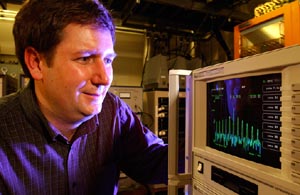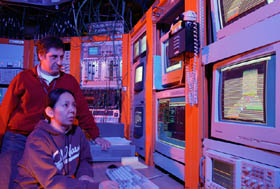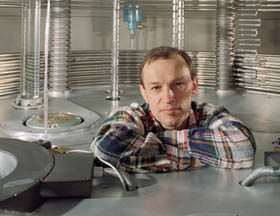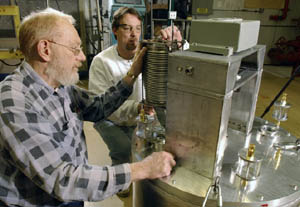 |
|
Movin' On Up by Matthew Hutson "Run II is not a construction project," Dan Lehman of the Department of Energy said in July of 2003. Lehman directs the DOE's Construction Management Support Division and regularly conducts reviews of large DOE projects. After reviewing Fermilab's Run II Luminosity Upgrade plan last July, he said, "Run II is a complex campaign of operations, maintenance, upgrades, R&D, and studies."
Experts from this and other labs around the world define each element of the plan through a series of technical reviews. These reviews, organized by Pushpa Bhat of the Computing Division, are essential to make sure that the plan is technically sound. The singular term Upgrade belies the plural nature of the project, which includes upgrades to seven of the eight linked accelerators. The Accelerator, Technical, Particle Physics, and Computing Divisions will perform upgrades continually during scheduled annual shutdowns and in the hours between data-collecting sessions.
STACK 'EM UP
To create pbars, the Main Injector sends a batch of protons towards the Antiproton Source, where they hit a stainless steel target. Slip stacking doubles the number of protons hitting the target. When in operation, two Booster batches of protons will travel around in MI at different speeds. When one slides up next to the other, they are combined together in one batch. But first the MI needs more radio frequency power to drive the protons around the ring. So Ioanis Kourbanis and MI technicians are doubling the number of RF amplifiers. "We're pretty optimistic that we're going to finish on time and we're going to get our goal," Kourbanis said.
COOL IT "Sergei Nagaitsev put together a very aggressive plan for [last year's] shutdown and got a lot of support," Spalding said. "He added new capability, he added new diagnostics, and he did a thorough bake-out of the vacuum system, and basically solved the problem."
An electron accelerator will create a cold electron beam and inject it into the Recycler. The electrons will mix with the pbars, and the more erratic pbars will share their thermal energy with the electrons. After 20 meters, a magnet will redirect the electrons away from the pbars. Alexander (Sasha) Shemyakin manages the electron cooling research at the Wide Band lab in the fixed target area. Electron cooling has been used before, but "nobody has done it with a beam this powerful," he said. In June, the team will move their equipment to MI31 next to the Recycler, and in August during the shutdown they'll install the final elements into the Recycler. They hope to have the process working by late 2005. With the Recycler and electron cooling fully operational, the transfer of pbar stacks from the Accumulator to the Recycler will be automated. Transfers will require only a minute and happen every half hour.
GETTING COLDER Another group will upgrade "stacktail cooling" in the Accumulator, which further refines the pbar stacks.
BEAM VS. BEAM The Tevatron uses 22 separators, pairs of metal plates generating electrical fields, to keep the two beams apart. One option is to add more separators, but this is expensive. The other option is to increase the voltage of the separators. Vladimir Shiltsev, Head of the Tevatron Department, and a team led by Ron Moore and Peter Limon, are researching new materials for the plates and doing beam studies. They should know by the end of 2004 whether they will install new separators or upgrade the existing ones. A beam in the Tevatron contains 36 separate bunches. After crossing paths inside CDF and DZero, the bunches get wider, some more than others. One solution is to install a magnet called an electron lens that can turn on and off rapidly enough to narrow individual bunches. Currently one lens is in testing at the Tevatron, with another on the way. "These are top-notch experiments," Shiltsev said. "It's the first electron lens ever." Scientists at the LHC are watching closely to see if it works. Fermilab also collaborates with SLAC, LBL, and Budker Institute of Nuclear Physics in Russia to study these "beam-beam" effects.
STEADY CLIMB The beamline between the target and the Debuncher ring has also been widened slightly to increase Debuncher acceptance of pbars. A team is currently studying the beamline using optical surveys, beam-based alignment techniques, and documentation to increase acceptance by rebuilding or relocating components or steering the beam differently. Ten quadrupole magnets in the Debuncher have been placed on motorized stands, and 20 more will receive the same treatment. Significant improvements in the Debuncher should continue to build up into 2007.
LOCATION, LOCATION, LOCATION
A fast solution is better than a perfect solution. "The idea is to get this system in place quickly so that the Tevatron department and others can use this information," Wolbers said. The upgrade should be complete by the end of the year. The CD will also work on hardware and software for the Tevatron Ionization Profile Monitors, or IPM's, which measure the size of the beam, and on several beam analysis projects around the lab.
ONE STEP AHEAD Paul Czarapata, Associate Division Head of Engineering in the AD, says people have the wrong idea about maintenance; they think it's completely separate from upgrades. When something breaks you don't just fix it; you improve it. "Maintenance is a continual upgrade," he said. "You've gotta stay one step ahead." Czarapata's keeps an eye on the lifetimes of equipment, on how it's used, on the status of replacement parts, on run schedules, and a number of other factors. With so many variables, "people make careers out of just studying when to do maintenance." Czarapata's biggest headache is securing spare parts for the Linac. The one vendor that makes the right power tubes is for sale, and its older engineers are retiring.
MANAGE THIS "Integration is important, but more important is having the right people doing the right jobs," Dixon told me. "From the beginning I knew that the potential existed within the Division for extraordinary accomplishments. Most of these are yet to come." Currently the integrated luminosity per week is around 11 inverse picobarnes (pb-1). At the beginning of Run II in 2001 it was around one pb-1, and by the end, it will probably reach between 28 and 47 pb-1. Total Run II integrated luminosity will probably reach between 4.4 and 8.5 thousand pb-1, or inverse femtobarnes. "We're doing a lot better but we've got a long way to go," Spalding said. "8.5 fb-1 we think is a realistic goal if every element of the plan works the way it's designed to work. We think it's realistic to be achieved and in fact on paper you can certainly exceed it." Even following the lower projection of 4.4, Run II would provide 30 times the integrated luminosity of Run I, and the subatomic realm holds no shortage of mysteries.
On the Web:
Accelerator Division:
Technical Division:
Particle Physics Division:
Computing Division: |
| last modified 4/8/2004 email Fermilab |
FRLsDFx9eyfrPXgV



